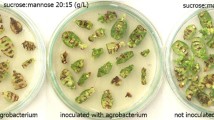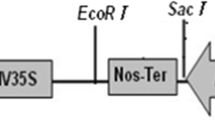Abstract
A new selection system for onion transformation that does not require the use of antibiotics or herbicides was developed. The selection system used the Escherichia coli gene that encodes phosphomannose isomerase (pmi). Transgenic plants carrying the manA gene that codes for pmi can detoxify mannose-6-phosphate by conversion to fructose-6-phosphate, an intermediate of glycolysis, via the pmi activity. Six-week-old embryogenic callus initiated from seedling radicle was used for transformation. Transgenic plants were produced efficiently with transformation rates of 27 and 23% using Agrobacterium and biolistic system, respectively. Untransformed shoots were eliminated by a stepwise increase from 10 g l−1 sucrose with 10 g l−1 mannose in the first selection to only10 g l−1 mannose in the second selection. Integrative transformation was confirmed by PCR, RT-PCR and Southern hybridization.




Similar content being viewed by others
Abbreviations
- pmi :
-
Phosphomannose isomerase
- 2,4-D :
-
2,4-Dichlorophenoxy acetic acid
- ABA :
-
Abscisic acid
References
Altmann T, Damm B, Halfter U, Willmitzer L, Morric PC (1992) Protoplast transformation and methods to create specific mutants in Arabidopsis thaliana. In: Koncz C, Chua N-H, Schell J (eds), Methods in Arabidopsis research. World Scientific Publishing Co., River Edge, NJ, pp 310–330
Barandiaran X, Pietro AD, Martin J, Di Pietro A (1998) Biolistic transfer and expression of a uidA reporter gene in different tissues of Allium sativum L. Plant Cell Rep 17:734–741
Eady CC, Lister CE (1998) A comparison of four selective agents for use with Allium Cepa L. immature embryos and immature embryo-derived cultures. Plant Cell Rep 18:117–121
Eady CC, Lister CE, Suo Y, Schaper D, Suo YY (1996) Transient expression of uidA constructs in in vitro onion (Allium cepa L.) cultures following particle bombardment and Agrobacterium-mediated DNA delivery. Plant Cell Rep 15:958–962
Eady CC, Weld JJ, Lister CE (2000) Agrobacterium tumefaciens mediated transformation and transgenic-plant regeneration of onion (Allium Cepa L.). Plant Cell Rep 19:376–381
Joersbo M (2001) Advances in the selection of transgenic plants using non-antibiotic marker genes. Physiol Plant 111:269–272
Joersbo M, Donaldson I, Kreiberg J, Petersen SG, Brunstedt J, Okkels FT (1998) Analysis of mannose selection used for transformation of sugar beet. Mol Breed 4:111–117
Joersbo M, Okkels T (1996) A novel principle for selection of transgenic plant cells: positive selection. Plant Cell Rep 16:219–221
Joubert P, Sangwan RS, Aouad MEA, Beaupere D, Snagwan Norereel BS (1995) Influence of phenolic compounds on Agrobacterium vir gene induction and onion gene transfer. Phytochemistry 40:1623–1628
Kim JY, Jung M, Kim HS, Lee YH, Choi SH, Lim YP, Min BW, Yang SG, Harn CH (2002) A new selection system for pepper regeneration by mannose. J Plant Biotechnol 4(3):129–134
Klein TM, Wolf ED, Wu R, Sanford JC (1987) High velocity microprojectiles for delivering nucleic acids in to living cells. Nature 327:70–73
Lucca P, Ye X, Potrykus I (2001) Effective selection and regeneration of transgenic rice plants with mannose as selective agent. Mol Breed 7:43–49
Claros MG, Canovas FM (1999) RNA isolation from plant tissues: a practical experience for biological undergraduates. Biochem Educ 27:110–113
Negrotto D, Jolley M, Beer S, Wenck AR, Hansen G (2000) The use of phosphomannose isomerase as a selectable marker to recover transgenic maize plants (Zea mays L.) via transformation. Plant Cell Rep 19:798–803
Scott A, Wyatt S, Tsou PL, Robertson D, Allen NS (1999) Model system for plant cell biology: GFP imaging in living onion epidermal cells. BioTechniques 26:1125, 1128–1132
Todd R, Tague BW (2001) Phosphomannose isomerase: a versatile selectable marker for Arabidopsis thaliana germ-line transformation. Plant Mol Biol Rep 19:307–319
Wang AS, Evans RA, Altendorf PR, Hanten JA, Doyle MC, Rosichan JL (2000) A mannose selection system for production of fertile transgenic maize plants from protoplasts. Plant Cell Rep 19:654–660
Wettasinghe R, Peffley EB (1998) A rapid and efficient extraction method for onion DNA. Plant Breed 117:588–589
Wright M, Dawson J, Dunder E, Suttie J, Reed J, Kramer C, Chang Y, Novitzky R, Wang H, Artim Moore L (2001) Efficient biolistic transformation of maize (Zea mays L.) and wheat (Triticum aestivum L.) using the phosphomannose isomerase gene, pmi, as the selectable marker. Plant Cell Rep 20:429–436
Zhang P, Potrykus I, Puonti-Kaerlas J (2000) Efficient production of transgenic cassava using negative and positive selection. Transgenic Res 9:405–415
Zhang P, Puonti-Kaerlas J (2000) PEG-mediated cassava transformation using positive and negative selection. Plant Cell Rep 19:1041–1048
Zheng SJ, Henken B, Sofiari E, Keizer E, Jacobsen E, Kik C, Krens FA (1998) Factors influencing induction, propagation and regeneration of mature zygotic embryo-derived callus from Allium cepa L. Plant Cell Tissue Organ Cult 53:99–105
Zheng SJ, Khrustaleva L, Henken B, Sofiari E, Keizer E, Jacobsen E, Kik C, Krens FA (2001) Agrobacterium tumefaciens-mediated transformation of Allium cepa L.: the production of transgenic onions and shallots. Mol Breed 7:101–115
Acknowledgements
We thank the Korean Federation of Science and Technology, Republic of Korea, for the financial support under ‘Brain pool project’ and ICAR, Government of India, for the study leave for C. Aswath. We also thank Syngenta seeds, Switzerland for sparing the pmi construct. We would like to acknowledge Dr Tim Conner for critically reviewing the manuscript.
Author information
Authors and Affiliations
Corresponding author
Additional information
Communicated by I. S. Chung
An erratum to this article can be found at http://dx.doi.org/10.1007/s00299-005-0105-2
Rights and permissions
About this article
Cite this article
Aswath, C.R., Mo, S.Y., Kim, D.H. et al. Agrobacterium and biolistic transformation of onion using non-antibiotic selection marker phosphomannose isomerase. Plant Cell Rep 25, 92–99 (2006). https://doi.org/10.1007/s00299-005-0022-4
Received:
Revised:
Accepted:
Published:
Issue Date:
DOI: https://doi.org/10.1007/s00299-005-0022-4




